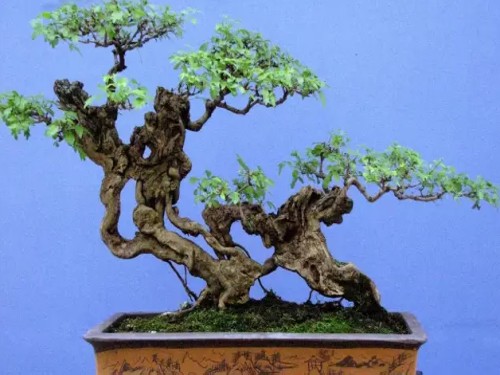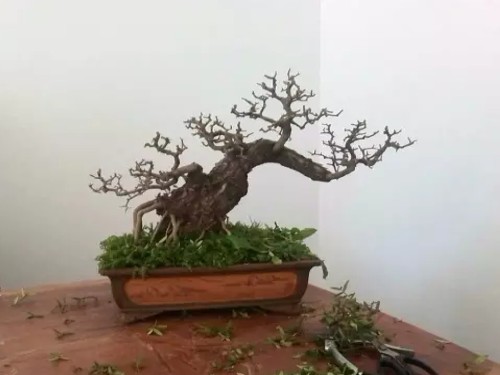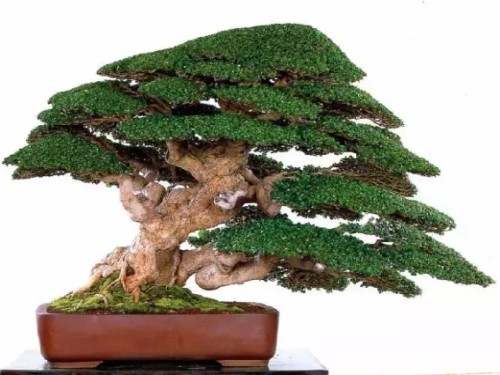Conception of design of potted landscape
Bonsai with trees as the main body, due to different materials, it is usually divided into "tree view" and "pile view" two categories. The tree scene is made of young trees and processed artistically, so it is often called "cultivation from childhood".
In the creation of bonsai trees, each part of a bonsai which can be called a masterpiece must be integrated, unified and coordinated. Otherwise, it is not a good work. In the modeling, the various ornamental parts of bonsai, including stem, branch, leaf, flower, fruit and root, should unify each other and develop harmoniously. That is, its shape, volume, color, lines, form, style and so on, require a certain degree of identity, similarity or consistency, giving people a unified and coordinated feeling. A successful bonsai modeling work must form a high degree of unity of complex changes. Only in this way can we form a "harmonious" artistic whole. The sense of unity in bonsai modeling should strive to: the unity of artistic conception, the unity of form, the unity of materials, the unity of techniques, the unity of lines, the unity of part and whole. Only in this way can we achieve unity and coordination.

In the real environment, there are very few trees that are truly perfect for the aesthetic shape of bonsai, and they often have a lot of limitations, or lack of branches, or smooth, or messy, or withered. This determines that bonsai artists need to make trees into an echo through artistic processing. It's nice and tight. Bonsai works of art with distinct layers, the combination of deficiency and reality, and as perfect as possible. Therefore, the modeling skills of bonsai trees are an indispensable part of making up for the defects of trees themselves and improving the aesthetic taste of bonsai art. Before the creation of bonsai art modeling, the first thing that must be considered is the overall conceptual design of tree modeling.
A complete bonsai work of trees embodies the wisdom and painstaking efforts of the artist, which can only be completed through his meticulous production. Therefore, the finished product can not be created overnight. It can be done with one wave, but it must be done after a few years. It can only be accomplished through the efforts of decades or even generations. Although time is constantly changing, the bonsai artists' expression intention and overall grasp of each work are always basically the same. Thus it can be seen that the conception and design orientation before the creation of bonsai art works is very important.
The "intention to write first" required by poetry writing is also applicable to the creation of bonsai works of trees. Due to the type of tree material. The characteristics are different, the images are different, and the gestures are various, which requires the makers to observe and ponder repeatedly according to the characteristics and forms of the tree materials to determine the modeling style and the conceptual intention expressed, so as to adjust measures to the conditions of the trees. To carry out the basic overall conception of the tree shape, draw a blueprint in mind, or draw a design composition on paper, to form a more complete idea of the festival, such as the straight and straight line of thought, the steepness and vastness of the oblique type, the tenacious tenacity of the wind type, and so on. These scenes are the epitome of the direct reflection of nature in the human brain, and the producer's idea is the combination of his ideas and the trees he needs to shape. It requires that it not only conforms to the natural reason, can not be fabricated out of thin air, but also higher than the natural scene, rather than the simple reproduction of nature, should "learn from nature" and better than nature. Through careful observation of the trees. Analysis. Research, take its major, get rid of its complexity, cut and process the original trees according to the design blueprint, and use the strengthening of art. Metamorphosis. Exaggeration and other techniques make the bonsai of trees to achieve the artistic beauty of "wild fun and natural beauty" although it is artificially created.
The roots of bonsai trees. Do it. Branch. Ye, should be the main consideration of the conceptual design object. The mutual cooperation of these four aspects not only determines the general direction of the overall tree design, but also determines the theme intention in the future. The same obliquely dried trees, using artificial skills, pass through the roots. The treatment of branches can be made into "oblique floating type" (water-facing type) or "cliff type" bonsai, or the same straight-dried trees can be made by climbing. Carve skills to make "dried" or "rotten" bonsai and so on. This is the subjective initiative of artificial modeling skills, according to the overall conception of design, the result of artistic processing. To sum up, the overall conceptual design of the overall shape of trees should consider the following problems:
1. Define the theme
A bonsai of trees is like a painting. A poem. A novel has the intention of expressing its central content. The difference is that the expression of painting and poetry is different. The expression of painting and poetry is the figure depicted by line color, the character and artistic conception depicted by text, while the tree expresses its theme content through image description, which makes people feel like they are there after the view. full of "poetic and picturesque". For example, if the theme is robust, the trunk of the tree must be rugged and sturdy, with luxuriant branches; if the theme is precipitous, it can be shaped like "the ends of the earth", so that the branches of the tree can be made high and twists and turns; and for the theme that shows vigor and wild interest, we should focus on depicting the rotten holes in the trunk of the tree. The characteristic of a short twig. Therefore, the theme of bonsai trees is actually a concentrated expression of people's feelings of the overall aesthetic point of view, ideas and image thinking. For the overall conception and design of bonsai modeling of trees, first of all, there must be a clear theme before the creator can determine good ideas and ideas, and create a distinct theme and vivid image. Interesting bonsai works of trees.
Second, distinguish between primary and secondary
Bonsai trees are like the notes and tones of music, although there are strong and weak, high and low, but the main tone is clear. Therefore, when determining the modeling intention of trees, we should make a clear distinction between primary and secondary, the part should obey the whole, highlight the main tone, and focus on rendering; to other local tone, it should be matched and set off, so that the work is rich in hierarchical changes and unified and harmonious as a whole. For example, the bonsai of "wind-blown" trees in ancient times should mainly highlight the changes in leaves; the bonsai of "exposed-root" trees with intertwined roots should give priority to changes in root systems; and the bonsai of "dried" trees that have experienced vicissitudes of life should give priority to highlighting the trunk, and so on.
3. Moderate trade-offs
As the bonsai of trees has the characteristics of continuous growth, it is a "living three-dimensional painting", which injects vitality into the bonsai works. But the growth of trees is not satisfactory, they often grow into messy branches and leaves, just like hemp. Bonsai makers should have a clear idea of such trees and size up the situation according to their overall image and determine the roots of the trees. Branch. Do it. The height of the leaves. Front and back. Left and right trade-offs, so that it is in line with the "shrinking dragon into an inch". The modeling rule of "see the whole through a small part". Such as: "straight strong" bonsai trees, the first branch should not be too low, too low will weaken the strong and straight spirit; and straight thick "big tree" bonsai trees, the first main branch should not be too high, too high will certainly weaken the characteristics of thick and luxuriant; works of sparse style, the trunk should be sparse but not dense; works with prosperous and luxuriant style should not be straight. The performance of a strong style of work, the backbone can be straight, and so on.
IV. Innovative ideas
Taking a comprehensive view of the development history of bonsai trees, each school has created and formed its own unique style. For example, the climbing technique of "one inch and three bends" of "Yangzhou School" has created a light and elegant "cloud film" style, while the "Lingnan School" has created the style of "storing branches and cutting dry", creating the style of running wild, and so on, all with the times. Custom. Climate. Constantly innovating and developing with the change of ideas, etc. It should be clear that modeling skills and style are the unity of opposites, modeling skills are the means, and create a new style. A new idea is the real goal. Our predecessors have explored and innovated bonsai art countless times, leaving us a precious legacy. Modern bonsai art should be "a hundred flowers blossom" and colorful, instead of wandering on the path of our predecessors, we should turn ordinary into magic, boldly innovate and develop, and create good works that can reflect the modern spirit. This requires bonsai artists to constantly improve their artistic attainments, modestly learn the styles and skills of bonsai art schools at home and abroad, absorb their various strengths and advantages, and enrich themselves. In the overall conception, we should constantly explore and innovate and enrich the content and style of the bonsai works to meet the needs of the development of the times.
As the saying goes: "works such as character, character such as works." What kind of aesthetic realm and aesthetic experience will have what kind of works, on the contrary, what kind of work level reflects the person's aesthetic taste and aesthetic pursuit. As a new generation of bonsai heirs, they should have a sense of mission and responsibility, while working hard to learn traditional techniques, they should also have the spirit of innovation and change, so as to make Chinese bonsai art have a long history.
Time: 2019-06-03 Click:
- Prev

Potting technique of bonsai with tree stump
Tree stump bonsai is referred to as stump bonsai. Woody plants are often used as production materials, and plants with graceful posture, short plants, compact leaves, long life, pruning resistance, strong resistance and easy modeling are selected to restrain their growth without violating the tree growth habits, picking leaves and coring, and carry out modeling processing.
- Next

Bare Root cultivation technique of Bonsai stump
With the further development of urban gardens and home courtyard beautification, the styling and landscaping of tree stumps has become more and more popular. In addition to the bonsai that can often be moved, people always linger on the landscaping of public green space and tree stumps in the courtyard, which shows that people advocate the state of mind of nature.
Related
- Fuxing push coffee new agricultural production and marketing class: lack of small-scale processing plants
- Jujube rice field leisure farm deep ploughing Yilan for five years to create a space for organic food and play
- Nongyu Farm-A trial of organic papaya for brave women with advanced technology
- Four points for attention in the prevention and control of diseases and insect pests of edible fungi
- How to add nutrient solution to Edible Fungi
- Is there any good way to control edible fungus mites?
- Open Inoculation Technology of Edible Fungi
- Is there any clever way to use fertilizer for edible fungus in winter?
- What agents are used to kill the pathogens of edible fungi in the mushroom shed?
- Rapid drying of Edible Fungi

